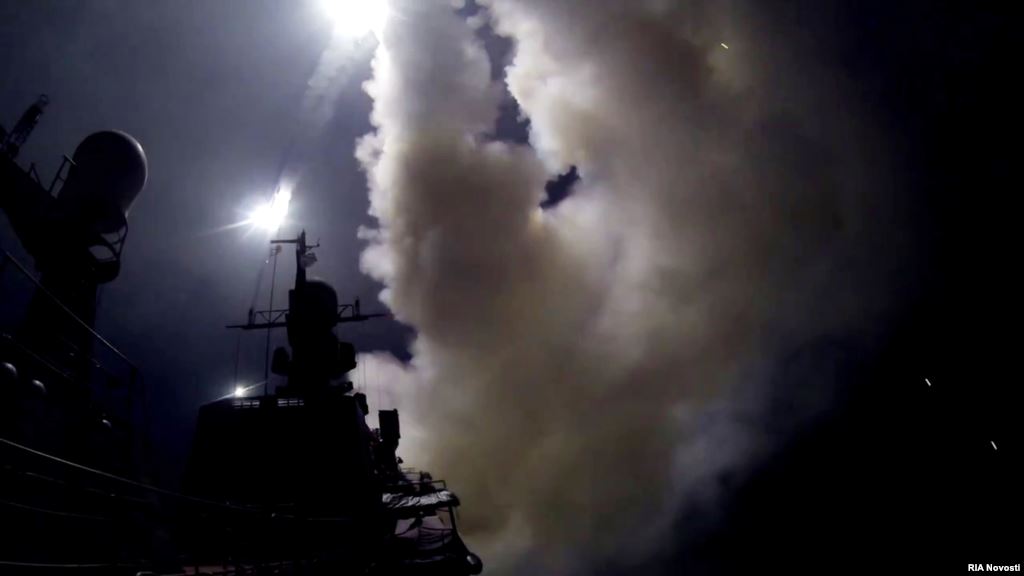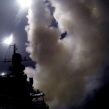
With Quickly Growing Russian Involvement, the Decisive Ground Offensive in Syria Begins
Publication: Eurasia Daily Monitor Volume: 12 Issue: 182
By:

The Russian state-controlled propaganda machine has been working around the clock to promote the success of Russia’s aerial bombing campaign in Syria, which began on September 30, to a reluctant domestic public. According to the independent pollster Levada-Tsenter, the propaganda has been effective: Over 70 percent of the Russian population supports the bombing of Islamic State (IS—also known as the Islamic State of Iraq and Syria, ISIS) targets in Syria; and about half believe Russia must support Syrian President Bashar al-Assad against the IS and the Syrian opposition. At the same time, half of the Russian population fears Syria may turn into a “new Afghanistan”—a costly and deadly long-term commitment that may end in defeat and humiliation, like the Soviet Afghan invasion in the 1980s, which lasted almost ten years and is still remembered with dread (Interfax, October 8).
The Ministry of Defense’s (MoD) daily briefings in Moscow show footage of airstrikes, allegedly killing “ISIS terrorists” in droves and destroying their weapons and infrastructure. The Russian defense and foreign ministries have been adamantly denying as “information warfare” claims that Russian bombs are mostly hitting not the IS, but the Syrian opposition and the civilian population. Foreign ministry spokesperson Maria Zakharova called on the United States to use a channel of communication between the Pentagon and the Russian MoD to clarify reports of alleged attacks on the Syrian opposition and resolve disagreements, instead of going public and discussing differences in the press (Kommersant, October 6).
The deputy chief of the General Staff of the Russian Armed Forces, chief of the main operational directorate, Colonel-General Andrei Kartapolov, told reporters the Russian bombardments of Syria are destroying the “infrastructure of the terrorists” and causing panic, “with some 600 ISIS mercenaries attempting to flee into Europe.” According to Kartapolov, the Russian MoD told the Pentagon beforehand about its plans to bomb IS targets and offered the US to cease all military activities and “withdraw all valuable local assets” from Syria. Kartapolov insisted the “Americans assured us there are only terrorists in these regions [Homs, Hama and Idlib]” (Rossyskaya Gazeta, October 3). Foreign Minister Sergei Lavrov told reporters that Moscow is ready to cooperate with the secular Free Syrian Army opposition group, if it, in turn, is ready to fight against the IS together with Russia and al-Assad’s forces. At the same time, Lavrov called the Free Syrian Army “a phantom structure,” claiming Moscow does not know who its leaders are or where its forces are deployed, or even whether it exists in reality (Interfax, October 5). Moscow insists: Everyone Russia bombs in Syria is a terrorist, connected to the Islamic State.
On President Vladimir Putin’s 63rd birthday (October 7), it was announced that the previous night 4 Russian naval ships fired 26 “Kalibr” 3M14 cruise missiles from the Caspian Sea at 11 designated targets in Syria to supplement the aerial bombardment by Russian jets based near Latakia, on the Syrian Mediterranean coast. Defense Minister Army-General Sergei Shoigu personally briefed Putin, who was spending his birthday at his Black Sea residence in Sochi. The “Kalibr” cruise missiles flew over 1,500 kilometers over Iran and Iraq to reach targets in Syria. This was the first time Russian naval-based cruise missiles were ever used in combat. The newest Russian “Kalibr” NK missile system is universal—it can launch missiles at naval and land targets at a distance up to 2,600 km. The Moskva rocket cruiser—at present, deployed close to the Syrian coastline—is armed with supersonic anti-ship P1000 Vulkan cruise missiles, which are not designed for use against land targets. Russian state TV has been hailing the successful launch of the “Kalibr” missiles as a demonstration of Russian military might and a snub to the US, which was allegedly unawares and did not anticipate or monitor the strike: “We have found a breach in the American armor.” The Russian Caspian flotilla has some of the most modern Russian naval ships armed with “Kalibr” NK launchers. The Black Sea fleet is still awaiting the delivery of frigates armed with “Kalibr” NK (Vesti, October 7).
The US does not have naval or air reconnaissance assets in the closed-water Caspian Sea that could monitor the launch and initial flight pattern of the “Kalibr” 3M14 cruise missiles. The volley of cruise missiles was a spectacular fireworks display marking Putin’s birthday and has demonstrated Russia is on par with the US in hitting far-off targets. But the military logic of the strike itself seems questionable. The “Kalibr” 3M14 cruise missiles reportedly hit targets close to Russia’s operational airbase at Latakia, mostly in Idlib province of Syria, well in range of Russian jets and bombs. The “Kalibr” 3M14 cruise missiles apparently use radar surface scanning for precision long-range hits (not GPS of GLONASS targeting), like the first-generation US Tomahawk cruise missiles, which makes them extremely expensive: $3 million to $6.5 million a piece. The entire volley of 26 missiles may, thus, have cost well over $100 million. It makes little sense to hit Syrian opposition targets with such expensive and stealthy weapons when these groups lack any air defenses and are already being bombed by Russian jets (Fontanka, October 7).
The volley of cruise missiles was apparently not only a birthday salute to the Russian president—it signaled the beginning of a major ground offensive in the provinces of Hama and Idlib by al-Assad’s forces, with Russian close air support, to flush out the Syrian opposition and possibly turn the tide of the Syrian civil war in al-Assad’s favor. The volley of cruise missiles could have been intended to further intimidate the opposition (Interfax, October 7). Reporters from Russia’s mass-circulation pro-Kremlin daily Komsomolskaya Pravda described flying on a Syrian government Mi-8 helicopter over Idlib province to drop leaflets. The leaflets promised free passage to surrendering opposition fighters and civilians fleeing the battle zone when the offensive begins. The leaflets describe the jihadists of the Islamic State and al-Nusra Front as “puppets of the US and Israel” (Komsomolskaya Pravda, October 4).
The Kremlin has continuously denied Russian troops will be involved in the land offensive. But as Russia provides close air support, there will surely be Russian spotter officers deployed in the Syrian regime’s ranks to correct the bombing as well as advisers and specialists. Will the opposition fighters hold their ground and mount a vicious resistance against unfavorable odds, or will they be rolled back under al-Assad’s attack and Russian bombs, retreating north into Turkey? The future of Putin’s Syrian adventure is being decided now on the ground.




